The Murder of Others
WEAPONS OF MASS DESTRUCTION, 19 Aug 2024
Scott Ritter | Consortium News – TRANSCEND Media Service
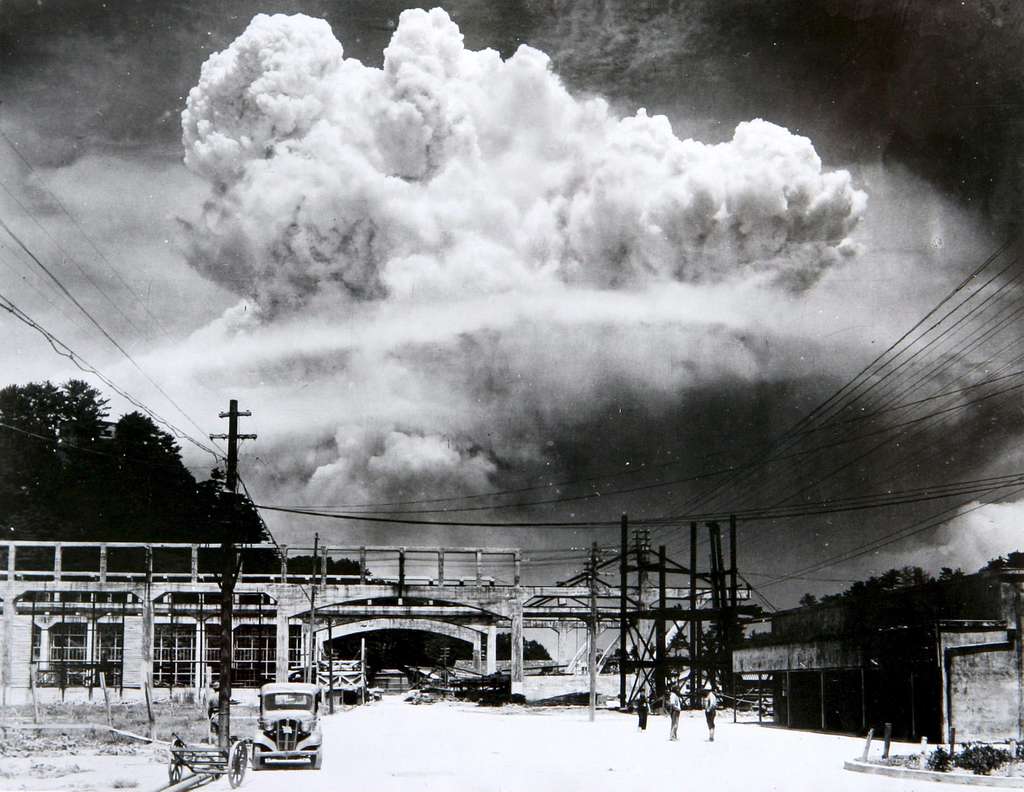
An atomic cloud hangs over the Japanese city of Nagasaki after the U.S. dropped a second nuclear bomb on the country on 9 Aug 1945.
(Hiromichi Matsuda, Wikimedia Commons, Public domain)
The U.S. has had a moral obligation to commemorate Nagasaki, but this year the U.S. refused to mark its murder of innocent Japanese by defending its murder of innocent Palestinians.
13 Aug 2024 – On June 18, 1945, President Harry Truman, who had taken over the presidency in April 1945 following the death of Franklin Roosevelt, convened a meeting in the White House cabinet room of his top military and diplomatic advisers to discuss the endgame strategy for defeating Japan.
Nazi Germany had surrendered in early May, and Truman was now dealing with the realities which accrued from that event. Under pressure from Congress, the U.S. had demobilized more than 450,000 soldiers in Europe, sending them home even as Truman wrestled with the probability of more than 260,000 U.S. casualties should he order the invasion of the southern Japanese island of Kyushu, part of the Japanese homeland (incredibly, Congress also authorized the demobilization of 30,000 troops in the Pacific, even though the war with Japan was far from over.)
In short, America’s appetite for war was waning.
Truman also had to deal with the issue of the victorious Soviet Red Army, which had played the leading role in defeating Nazi Germany and, as a result, now occupied all eastern Europe and half of Germany, including its capital, Berlin.
Ignoring the fact that the Soviet Union and its leader, Joseph Stalin, were exhausted by a war that had destroyed a third of its industry and killed more than 27 million of its citizens and, as such, were looking for peace, not a new war with the West, Truman fell under the sway of his closest advisers, including his choice to be secretary of state, James Byrnes, who viewed the Soviets as a threat that had to be contained and, if necessary, confronted by U.S. military power in the post-war period.
How to square the need to simultaneously defeat Japan, deal with the increasing political pressure to demobilize, and present a strong military posture to the Soviet Union was one of the more pressing challenges facing Truman and the men he had gathered in the White House cabinet room.
The answer lay in the atomic bomb — J. Robert Oppenheimer’s “gadget ”— which was, at the time of the June 18 meeting, being prepared for testing in the badlands of New Mexico.
The huge responsibility that attached itself to the existence and potential use of this new weapon weighed heavily on the attendees. During this meeting, Secretary of War Henry L. Stimson reminded those present that
“our leadership in the war and in the development of this weapon [the atomic bomb] has placed a certain moral responsibility upon us which we cannot shirk without very serious responsibility for any disaster to civilization which it would further.”
When the discussion turned to the use of the atomic bomb as a “war winning” tool designed to break the spirit of the Japanese and compel them to surrender unconditionally, Assistant Secretary of War John J. McCloy proposed a compromise: why not show flexibility regarding the need for “unconditional surrender,” such as allowing the Japanese emperor to stay in place as the head of state, and, as a way of reinforcing to the Japanese the reality of America’s overwhelming superiority in arms, tell the Japanese about the existence of the atomic bomb, giving them the clear option of capitulating under reasonable terms or watching their cities be destroyed?
Truman, intrigued with the concept, had McCloy take his proposal to Byrnes to see what the future secretary of state thought about it (Byrnes was, at the time, in the process of being confirmed by the U.S. Senate).
Byrnes, concerned about the perceived threat from the Soviet Union, rejected McCloy’s proposal, opting instead to go forward with the use of the atomic bomb on Japan with the dual mission of helping bring a rapid end to the war with Japan and, perhaps more importantly, since McCloy and others believed Japan was ready to surrender, obviating the need to use the bomb, as a demonstration of U.S. military power to the Soviet Union in an effort to deter any post-war antics on their part in Europe.
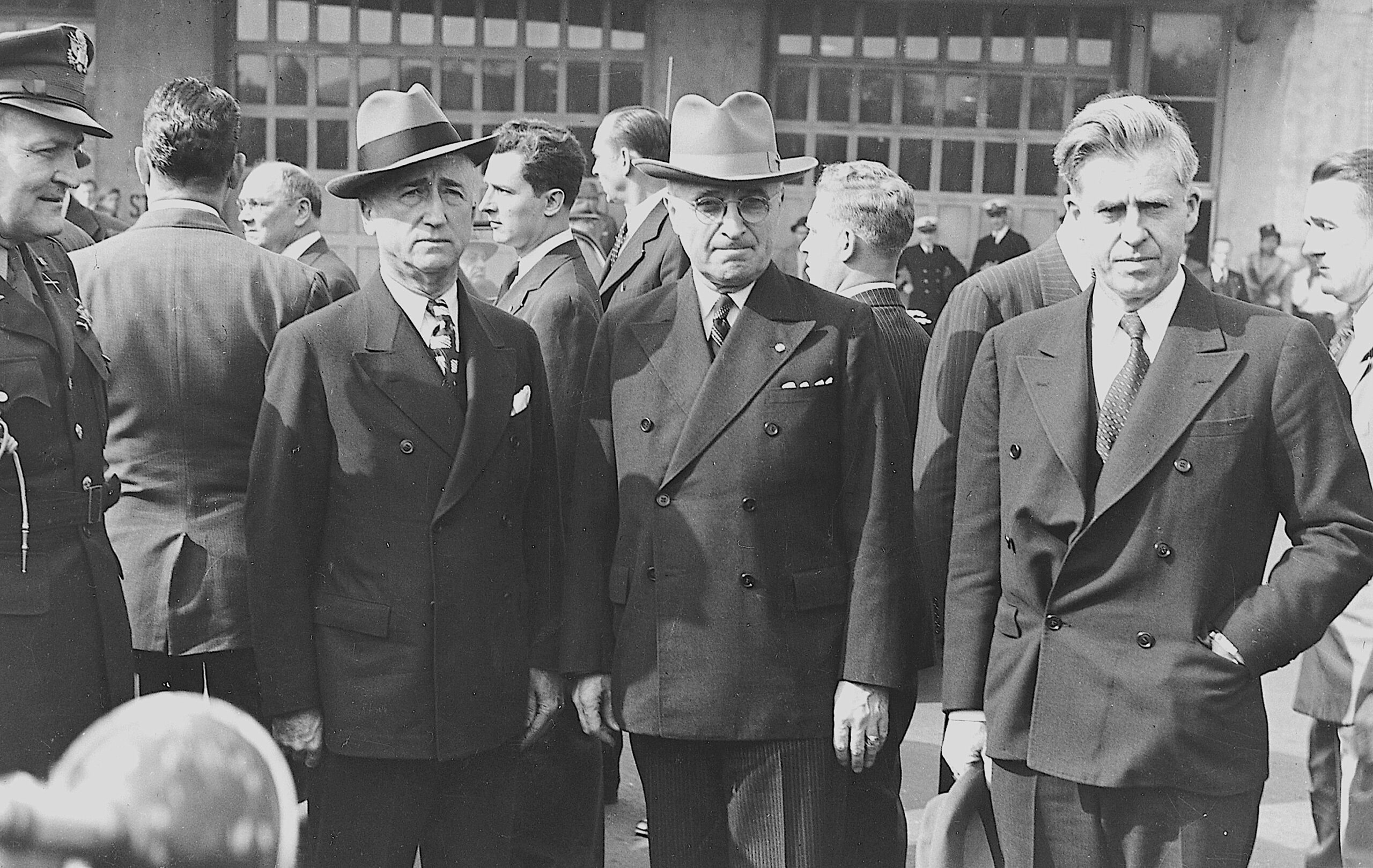
From left: James F. Byrnes, President Harry S. Truman, and Henry A. Wallace, during President Franklin D. Roosevelt’s funeral, April 14, 1945. (Abbie Rowe, U.S. National Archives, Wikimedia Commons)
Byrnes’ strategy, however, was nonsensical given what subsequently transpired. On July 17, 1945, Truman was in Potsdam, Germany, for a major post-war conference with Joseph Stalin and British Prime Minister Winston Churchill (the “Big Three”).
The day before, July 16, Oppenheimer had successfully tested a prototype of a plutonium bomb in the deserts of Alamogordo, New Mexico. (Oppenheimer and his team of nuclear scientists had also developed an atomic bomb that made use of highly enriched uranium as its core. This weapon was far simpler in its design, and as such the need to test it was not as acute.)
Truman revealed the existence of this weapon to Stalin on July 24. The Soviet leader, nonplussed, said he hoped the Americans would put it to good use against the Japanese. Stalin had committed to entering the war against Japan no later than Aug. 15.
Soviet forces, fresh from their victory over Nazi Germany, were being redeployed to the Soviet Far East, where they would be used to defeat the more than 1 million Japanese soldiers who occupied northern China and Korea.
With the promised involvement of the Red Army, the military defeat of Japan was assured. Truman, in notifying Russia of the existence of the bomb, had put the Soviets on notice about the reality of American military might.
There was, literally, no valid reason to drop an atomic bomb on a Japanese city.
Denying the Soviets in Post-War Asia
Truman, however, under the influence of Byrnes, began to worry about the Soviets gaining a dominant position in post-war Asia. Rather than cancelling his order to use America’s horrible new weapon, he allowed the attack to go through in hopes that it would cause the collapse of Japan before the Soviet Army began its offensive, thereby denying the Soviets the opportunity to expand their influence in the Pacific.
Japan’s fate was sealed.
Much has been written about the American use of an atomic bomb on the Japanese city of Hiroshima on Aug. 6, 1945. The name of the B-29 that dropped this weapon of mass destruction, the Enola Gay, and the name of the pilot who flew the aircraft, Paul Tibbets, have gone down in history.
A “Target Committee” formed in April 1945 nominated five Japanese cities as candidates for attack using the atomic bomb: Kokura (today known as Kitakyushu), Hiroshima, Yokohama, Niigata, and Kyoto. At some point someone had amended the list by writing in “Nagasaki” by hand.
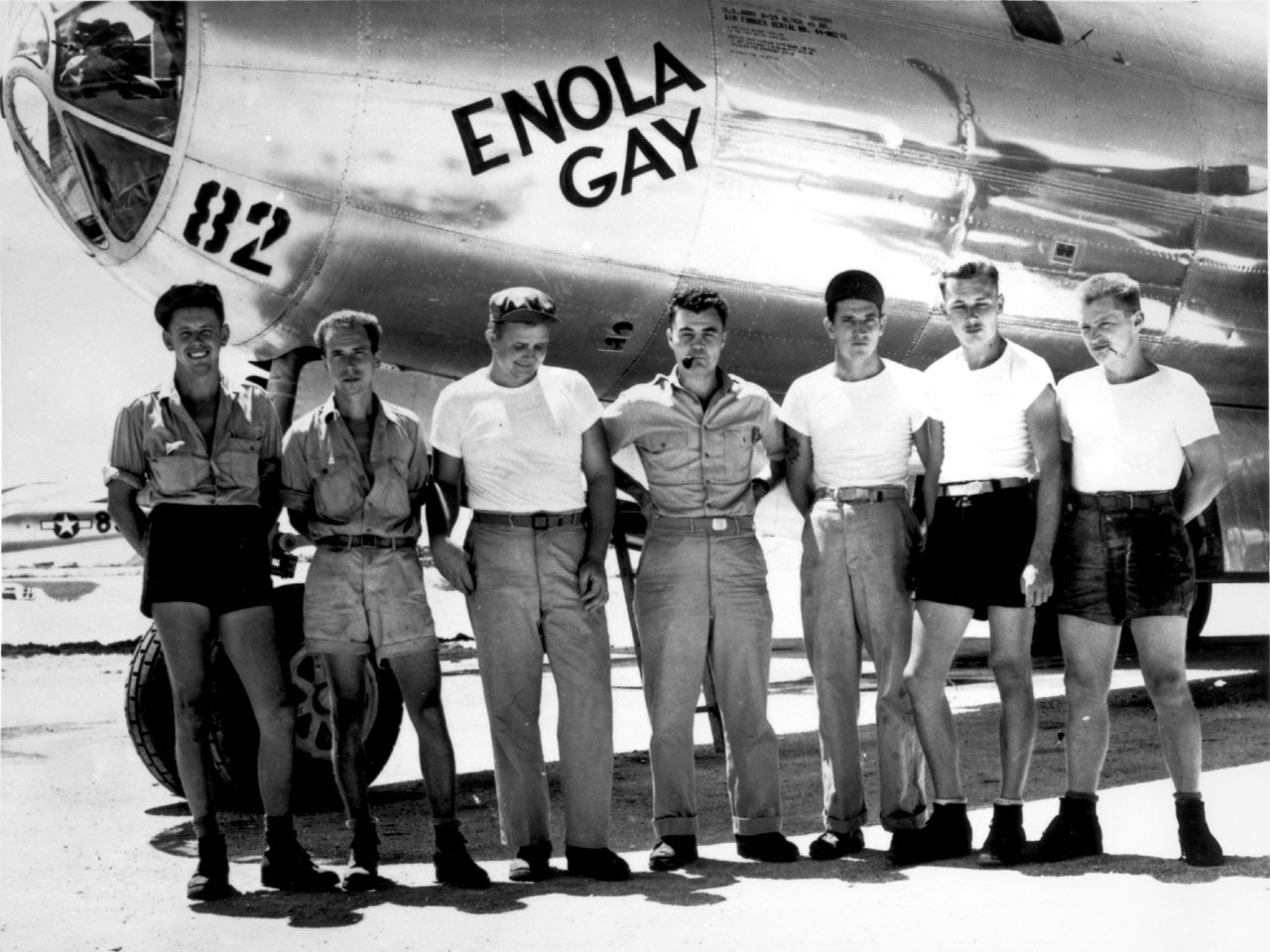
The ground crew of the B-29 “Enola Gay” which atom-bombed Hiroshima, Japan. Col. Paul W. Tibbets, the pilot is in the center. (Public domain)
The reasoning behind this last-minute change had nothing to do with military matters. Rather, it came at the request of Secretary of War Stimson who personally asked Truman to remove Kyoto from the list because Stimson had honeymooned there years ago and was taken by its beauty and culture.
The committee had considered the psychological importance of the use of the atomic bomb, both in terms of its impact on the Japanese people, but also as to make “the initial use sufficiently spectacular for the importance of the weapon to be internationally recognized when publicity on it is released.”
The Soviet Union, it seemed, had to be put on notice about the terrible reality of American nuclear supremacy (the hubris contained in this objective is underscored by the fact that, thanks to the work of Soviet intelligence, Stalin was already aware of the U.S. atomic bomb project, and, in 1942, had tasked his own scientists to begin work on building a Soviet bomb which, when tested in 1949, ended America’s short-lived nuclear supremacy.)
Hiroshima Attacked
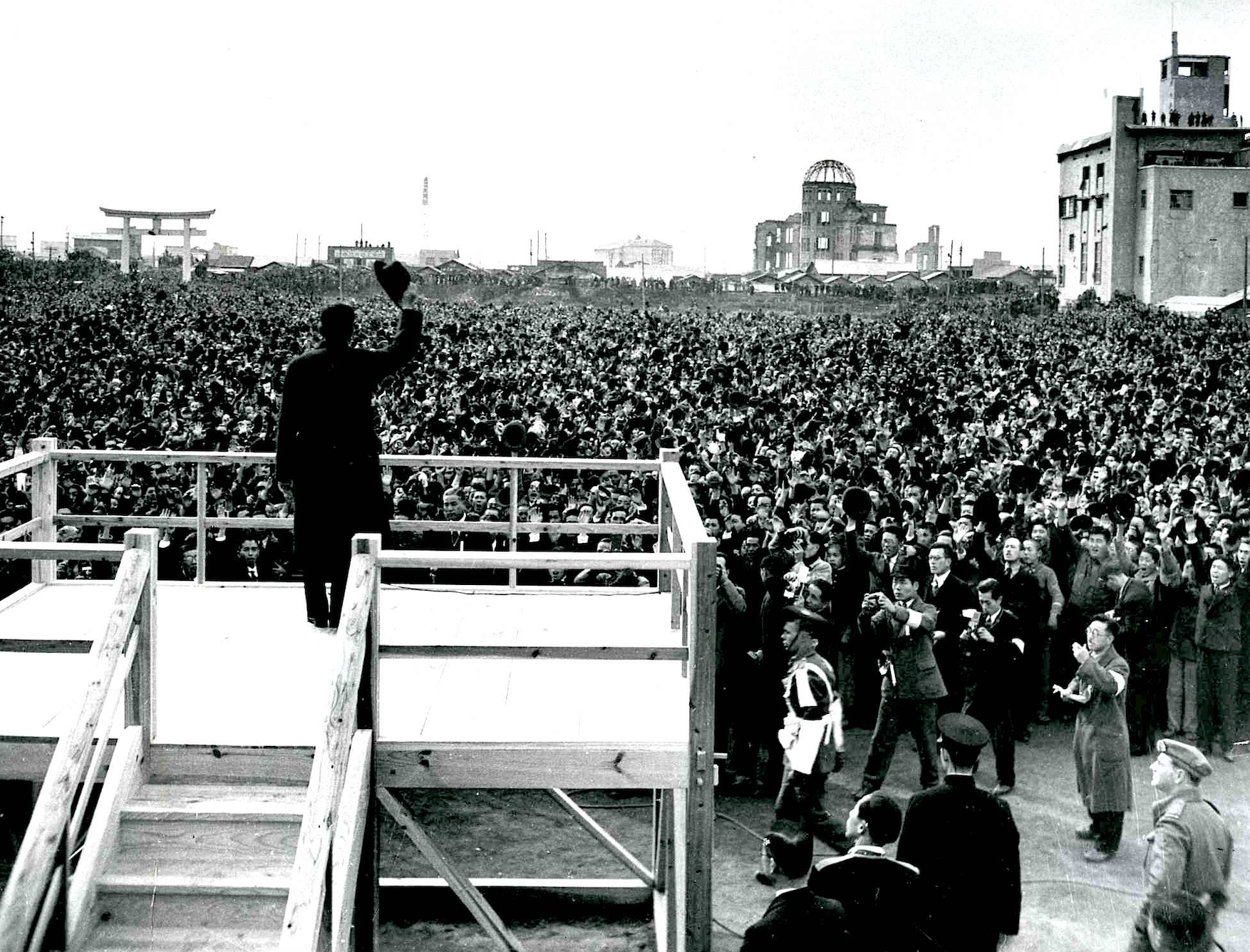
Emperor Hirohito visiting Hiroshima in 1947; the dome of what would become the Hiroshima Peace Memorial can be seen in the background. (Asahi Shimbun Company, Wikimedia Commons, Public domain)
Hiroshima was attacked and destroyed on Aug. 6, 1945. It is estimated that 66,000 Japanese were killed by the immediate effects of the weapon, and that an additional 100,000 were killed by the end of 1945 from injuries sustained during the attack.
The Hiroshima attack made use of the “Little Boy” atomic weapon — the simpler enriched uranium weapon that had not been tested previously.
The next attack on Japan using an atomic bomb was scheduled for Aug. 11. This attack would make use of the “Fat Man” plutonium weapon that had been successfully tested back on July 16.
Intelligence reports were trickling into the White House about the impact the Hiroshima attack had on the Japanese government.
While the Japanese military was reticent about recognizing the danger posed to Japan by the revelation of this new American weapon (Japan had been engaged in its own abortive atomic bomb program, and assessed that even if the U.S. had dropped such a weapon on Hiroshima, its inventory of available weapons would be very limited, and Japan should, therefore, simply ride out the storm), the Japanese emperor was of a different mind.
In talks with Foreign Minister Shigenori Togo on Aug. 8, Emperor Hirohito declared that the war must end. Togo later confirmed that it was the atomic bomb attack on Hiroshima that led the Japanese Emperor to this conclusion.
Fate, however, intervened.
On Aug. 7, one day after the Hiroshima bombing and one day before Hirohito made his decision to end the war, the American commanders involved in the implementation of the July 24 strike order which directed that Japan be attacked using the atomic bomb beginning after Aug. 3, and continuing as weapons became available, met to discuss the next attack.
When informed that the “Fat Man” device could be assembled for use by Aug. 11, Paul Tibbets — the pilot of Enola Gay — noted that the weather over Japan was predicted to be bad that day, and requested that the bomb assembly be completed by Aug. 9.
Fatal Decision for Nagasaki
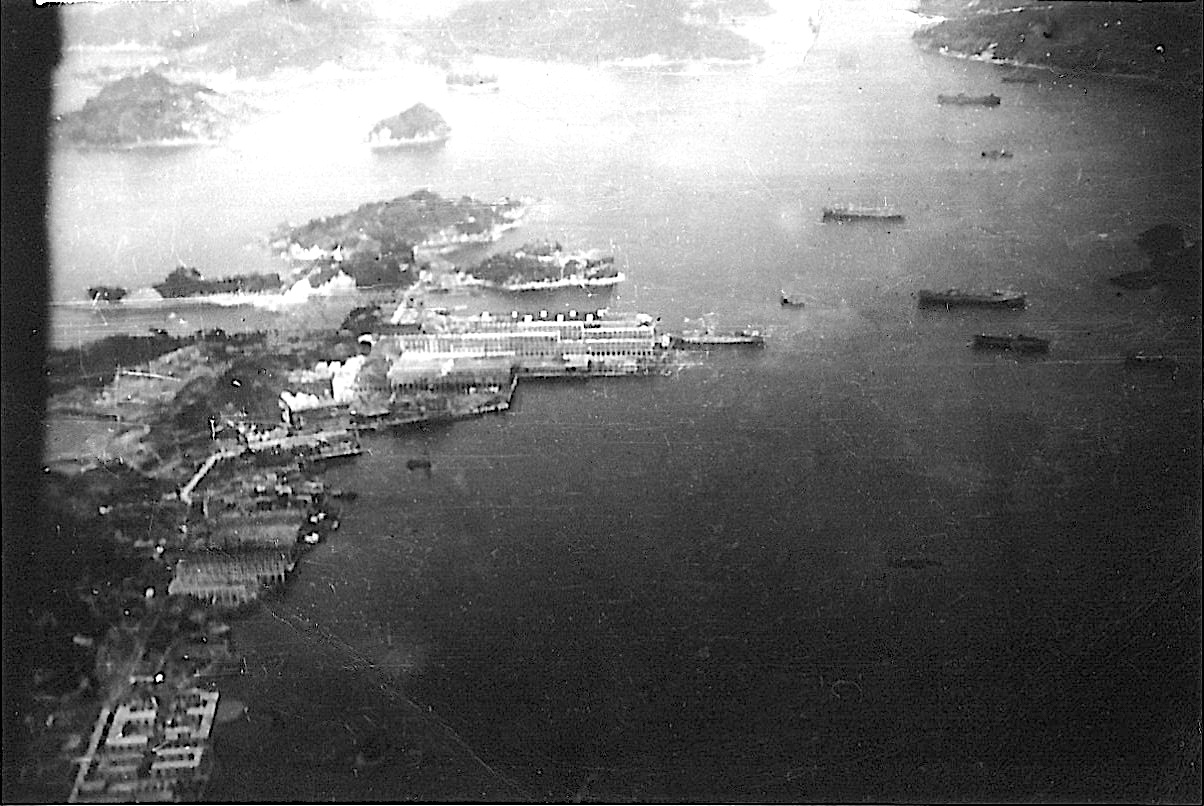
The harbor at Nagasaki in August 1945 before the city was hit with the atomic bomb. (Flight Officer Bruce C. Saxton, Wikimedia Commons, Public domain)
This decision proved to be fatal for the citizens of Nagasaki. Had the original Aug. 11 attack date been retained, it is highly likely that Hirohito would have communicated his desire to end the war in time to forestall a second attack.
There was one other factor that needs to be considered — the Aug. 9 Soviet decision to begin combat operations against Japan. This action led to the Japanese declaring martial law, which would have complicated any potential for peace.
Could Hirohito have prevailed over his generals to end the war had he been given two days to consult? We will never know, because on Aug. 9 the U.S. dispatched a B-29 nicknamed Bockscar, flown by Charles Sweeney, to drop the “Fat Man” plutonium bomb on a second Japanese city.
Nagasaki was not the intended target. That honor fell to the city of Kokura. However, a mixture of clouds, haze, and smoke made visual acquisition of the target impossible (given the desire to achieve the maximum damage of a target, the crews piloting the atomic bomb-armed B-29’s were prohibited from using radar for target acquisition, as any significant deviation from the intended aim point would reduce the level of destruction being sought by the U.S. command.)
Instead, very specific visual target recognition standards were implemented. These standards saved the citizens of Kokura.
Nagasaki was likewise almost saved by similar factors. At the last second (the B-29 had suffered a fuel pump malfunction and was running dangerously low on fuel), the bombardier observed the specific aiming point, and guided the B-29 to its target.
As a direct result of the resulting explosion, 60,000 Japanese were estimated to have been killed with another 30,000 perishing from the results of the attack by year’s end.
The Nagasaki attack took Truman by surprise — he seemed unaware that the bombing of Japan using atomic bombs was on fully automatic as long as there were bombs and targets available. Reports about the horror inflicted on Hiroshima were coming into the White House, and the horror of what he had unleashed was starting to take root.
On Aug. 10, Truman directed that there would be no more atomic bomb attacks on Japan without his express permission, saving the citizens of Kokura and Niigata from nuclear slaughter (Yokohama had been removed from the list because it had been bombed with conventional munitions in late July and the targeting team wanted only “fresh” targets so that the full effect of the destructive power of the atomic bomb could be assessed.
Had the “Fat Man” bombing been scheduled for its original date — Aug. 11 — it is possible that Truman, having become better appraised of the destructiveness of the Hiroshima weapon — would have ordered a cessation in atomic attacks prior to the attack going through.
And the murder of the citizens of Nagasaki would never have occurred.
But it did, and every year since, the citizens of Nagasaki have gathered to commemorate this dark day in their history.
It is a solemn moment, one that is not meant to be politicized.
For this reason, the mayor of Japan decided not to invite Israel to the ceremony out of concerns that anti-Israeli (and pro-Palestinian) demonstrators might disrupt the proceedings.
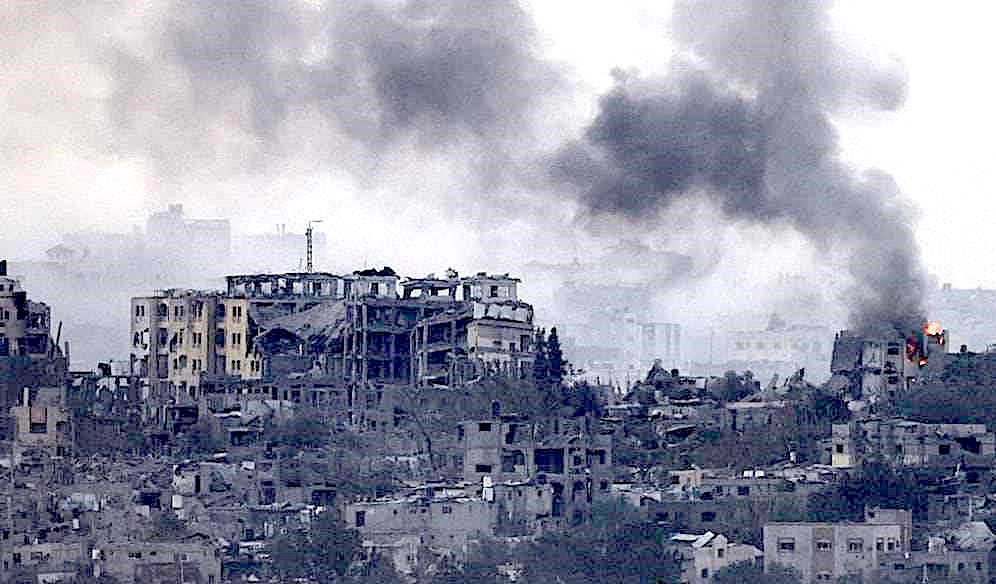
Damaged buildings in Gaza, Dec. 6, 2023. (Tasnim News Agency, Wikimedia Commons, CC BY-SA 4.0)
The U.S. ambassador to Japan, Rahm Emmanuel, informed the mayor that he would not be attending the ceremony unless Israel was invited to participate.
The very notion that the United States — the nation responsible for the atomic attack on Nagasaki — would opt out of attending the commemoration of its mass murder of Japanese because it instead opted to defend the honor of a nation, Israel, which is actively engaging in mass murder – indeed genocide against the people of Gaza – is mind boggling.
Unless you’re an American government official.
In which case, it makes perfect sense to defend one mass murder by ignoring your complicity in the murder of others.
________________________________________
 Scott Ritter was a US Marine Corps intelligence officer for 12 years. As a chief weapons inspector for the UN Special Commission in Iraq, he was labeled a hero by some, a maverick by others and a spy by the Iraqi government. In charge of searching out weapons of mass destruction within Iraq, Ritter was on the front lines of the ongoing battle against arms proliferation. He has had an extensive and distinguished career in government service with assignments in the former Soviet Union and the Middle East. In 1991, Ritter joined the United Nations weapons inspections team, or UNSCOM. He participated in 34 inspection missions, 14 of them as chief inspector. Ritter resigned from UNSCOM in August 1998, citing U.S. interference in the inspections. He is the author of many books, including Scorpion King: America’s Suicidal Embrace of Nuclear Weapons from FDR to Trump; Iraq Confidential: The Untold Story of the Intelligence Conspiracy to Undermine the UN and Overthrow Saddam Hussein; Target Iran: The Truth about the White House’s Plans for Regime Change; and Waging Peace: The Art of War for the Antiwar Movement. Contributor author: Deal of the Century: How Iran Blocked the West’s Road to War, Clarity Press. He is a graduate of Franklin and Marshall College, with a B.A. in Soviet history.
Scott Ritter was a US Marine Corps intelligence officer for 12 years. As a chief weapons inspector for the UN Special Commission in Iraq, he was labeled a hero by some, a maverick by others and a spy by the Iraqi government. In charge of searching out weapons of mass destruction within Iraq, Ritter was on the front lines of the ongoing battle against arms proliferation. He has had an extensive and distinguished career in government service with assignments in the former Soviet Union and the Middle East. In 1991, Ritter joined the United Nations weapons inspections team, or UNSCOM. He participated in 34 inspection missions, 14 of them as chief inspector. Ritter resigned from UNSCOM in August 1998, citing U.S. interference in the inspections. He is the author of many books, including Scorpion King: America’s Suicidal Embrace of Nuclear Weapons from FDR to Trump; Iraq Confidential: The Untold Story of the Intelligence Conspiracy to Undermine the UN and Overthrow Saddam Hussein; Target Iran: The Truth about the White House’s Plans for Regime Change; and Waging Peace: The Art of War for the Antiwar Movement. Contributor author: Deal of the Century: How Iran Blocked the West’s Road to War, Clarity Press. He is a graduate of Franklin and Marshall College, with a B.A. in Soviet history.
Go to Original – consortiumnews.com
Tags: Gaza, Genocide, Hiroshima and Nagasaki, Israel, Japan, Palestine, Pentagon, US empire, USA, WMD
DISCLAIMER: The statements, views and opinions expressed in pieces republished here are solely those of the authors and do not necessarily represent those of TMS. In accordance with title 17 U.S.C. section 107, this material is distributed without profit to those who have expressed a prior interest in receiving the included information for research and educational purposes. TMS has no affiliation whatsoever with the originator of this article nor is TMS endorsed or sponsored by the originator. “GO TO ORIGINAL” links are provided as a convenience to our readers and allow for verification of authenticity. However, as originating pages are often updated by their originating host sites, the versions posted may not match the versions our readers view when clicking the “GO TO ORIGINAL” links. This site contains copyrighted material the use of which has not always been specifically authorized by the copyright owner. We are making such material available in our efforts to advance understanding of environmental, political, human rights, economic, democracy, scientific, and social justice issues, etc. We believe this constitutes a ‘fair use’ of any such copyrighted material as provided for in section 107 of the US Copyright Law. In accordance with Title 17 U.S.C. Section 107, the material on this site is distributed without profit to those who have expressed a prior interest in receiving the included information for research and educational purposes. For more information go to: http://www.law.cornell.edu/uscode/17/107.shtml. If you wish to use copyrighted material from this site for purposes of your own that go beyond ‘fair use’, you must obtain permission from the copyright owner.
Join the discussion!
We welcome debate and dissent, but personal — ad hominem — attacks (on authors, other users or any individual), abuse and defamatory language will not be tolerated. Nor will we tolerate attempts to deliberately disrupt discussions. We aim to maintain an inviting space to focus on intelligent interactions and debates.
Read more
Click here to go to the current weekly digest or pick another article:
WEAPONS OF MASS DESTRUCTION: